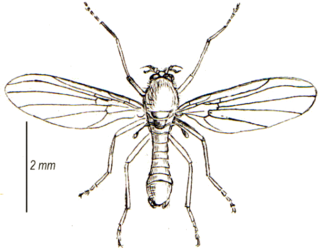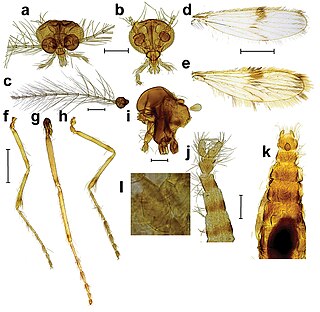
Ceratopogonidae is a family of flies commonly known as no-see-ums, or biting midges, generally 1–3 millimetres in length. The family includes more than 5,000 species, distributed worldwide, apart from the Antarctic and the Arctic.

Thaumaleidae, the solitary midges or trickle midges, are a group of nematoceran flies related to the Ceratopogonidae, Chironomidae, and the Simuliidae. They are small, stocky, yellow to brown flies (3–4 mm). Very few species are known for this family. Larvae are found in films on rocks and the nonfeeding adults are usually found on foliage along the same streams in which the larvae are found. A few solitary midges are found in the Southern Hemisphere, but Thaumaleidae are generally an Holarctic family.

Culicoides is a genus of biting midges in the family Ceratopogonidae. There are over 1000 species in the genus, which is divided into many subgenera. Several species are known to be vectors of various diseases and parasites which can affect animals. The genus has a long fossil record, with earliest known fossils being from Burmese amber, around 99 million years old.

Corethrella is a genus of midges that are classified in the family Corethrellidae.

Leptoconops is a midge genus in the family Ceratopogonidae. It has a mostly tropical or subtropical distribution worldwide, but some species occur as far north as Moscow region in Russia and the Yukon Territory in Canada.

Atrichopogon is a genus of biting midges, small flies in the family Ceratopogonidae.
Probezzia is a genus of biting midges in the family Ceratopogonidae. There are at least 20 described species in Probezzia.
Forcipomyia fuliginosa is a species of biting midges.
Downeshelea is a genus of predaceous midges in the family Ceratopogonidae. There are more than 20 described species in Downeshelea.
Phaenobezzia is a genus of biting midges in the family Ceratopogonidae. There are more than 20 described species in Phaenobezzia.
Forcipomyia bipunctata is a species of biting midges from Europe and North America.
Forcipomyia pictoni is a species of biting midges.
Forcipomyia glauca is a species of biting midges.
Nilobezzia is a genus of biting midges in the family Ceratopogonidae. There are more than 70 described species in Nilobezzia.
Forcipomyia pluvialis is a species of biting midges.
Allohelea is a genus of predaceous midges in the family Ceratopogonidae. There are more than 30 described species in Allohelea.

Heteromyia is a genus of biting midges in the family Ceratopogonidae. There are about 17 described species in Heteromyia.
Forcipomyia bystraki is a species of biting midges from North America.
Forcipomyia fairfaxensis is a species of biting midges.





